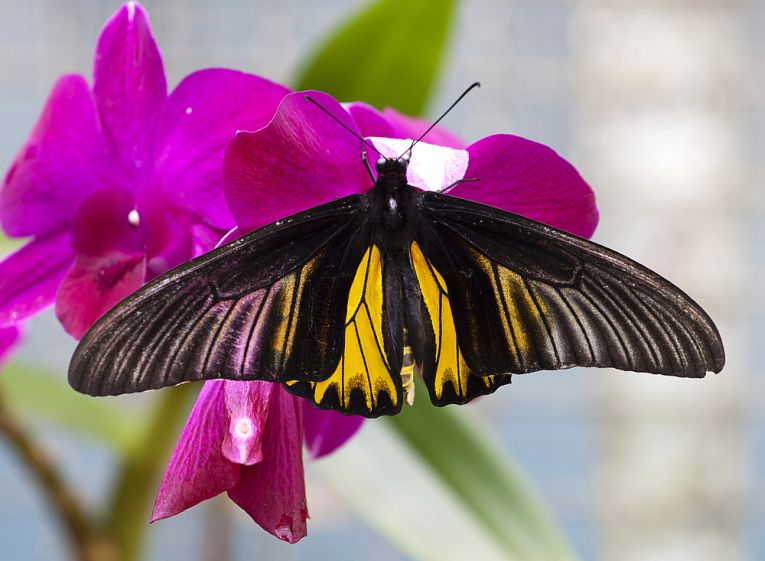The use of butterfly breeding by Papua New Guinea villages was recently brought up as an example of conservation in action. The 1997 (and previous) articles by Larry Orsak, who directed the Christensen Research Institute in Madang at the time, was one of the original reports. The 3 authors here, rather than destroy the forest by logging, argued for strategies that would enable forest people to hunt, harvest and develop their own resources in ways that maintain the habitat. Sustainability of course is the aim, with hopefully some regeneration of forest in these areas. The 2 main butterflies involved are the world’s largest and fastest, the Queen Alexandra and Goliath birdwings.
To clarify the position, empowerment of local interests is one of the keys to sustainable development. The alternative is large scale farming or deforestation such as that developing oil palm, sugar cane or similar cash crop monocultures. If logging or mining were adopted in any specific location, some local employment would be expected to enhance the regional economy in a minor way, while all such loss of habitat must obviously have limits. We need to assess just where that limit is for every case, with an obvious input needed from local people. The struggle against loggers was shown up in our 2014 article, highlighting the problems for Indonesian fauna.
The butterflies of both Indonesia and Papua New Guinea have been shown to help, because rare butterflies are “common” in the few remaining tropical forest areas, as they rapidly decrease in area. As Larry describes, at that time, people bought products of the rainforest
such as Brazil nuts to support tropical conservation efforts. He notes how the PNG government set up an Insect Farming and Trading Agency(IFTA) in Bulolo with sales of $400,000 pa. Only villagers were allowed to sell the insects to this agency, with the 2 largest birdwings (in the world!) being especially bred in gardens with Aristolochia
and its pipevine relatives as their foodplant.
When the villagers sustainably manage their insects, prices can be maintained with increases and consumer demand related to conservation outcomes. While suggestions on selling non-rare species are commendable, it is hard to understand how demand would continue for butterflies, beetles or similar items unless the market was unfairly manipulated. It is obvious that plants, feathers and other almost touristic sales products might need to be developed, given great insight into worldwide popularity. Collectors of butterflies for example would possibly be very good customers, while there could be a limited market for items where there was no long-established demand.
One example that can be observed in action is in The Gambia. Villagers there have used palm leaf furniture (the coconut-like Rhun palm, Borassus aethiopum), honey and tree nurseries to spark their forest product industries into life, given a pre-existing eco-tourism interest on the large Gambia River. Community forests replaced some of the state-managed forestry projects in the 1990s, but these local industries were unfortunately not developed then. Fuel wood is admittedly one of the forest products that elsewhere has caused desertification and gradual deforestation. Here in The Gambia, $50 of wood has become worth $700 because communities organised themselves into a federation. The FAO drew attention to this hopefully good news in 2005.
To bring things up-to-date across the continent, this year has seen Tanzania gain renewed interest in forest logs and trees. With a modern tractor for their farming activity, Nahanga villagers have used their governments Kilmo kwanza initiative (using finance from Finland) to use forest products to subsidise their agriculture. They also built an office and a health centre. The Nahangans bought their own forest, then sold scrub and cleared wood as fuel. Lack of facilities to sell forest products has obviously stopped many villages from following the lead of Nahanga, but the education into the many possible ways of benefiting from abundant forest resources is a very big problem. Whether butterflies or other insects can be sold, whether nuts from the palms or other trees have any value other than basic food are questions we all need to answer for forest peoples everywhere. From colder rain foresst in North America or Tasmania to the truly tropical variety, the biodiversity is never questioned. Such resources need advertising to not just developed areas, but also the very people who could profit from their local produce.
Everyone, including the climate changers needs these forest resources for very different reasons. There is an equally complex set of reasoning behind their potential. Whether we buy something from the forests or reject it depends on those who work today for or in these dwindling resources.










